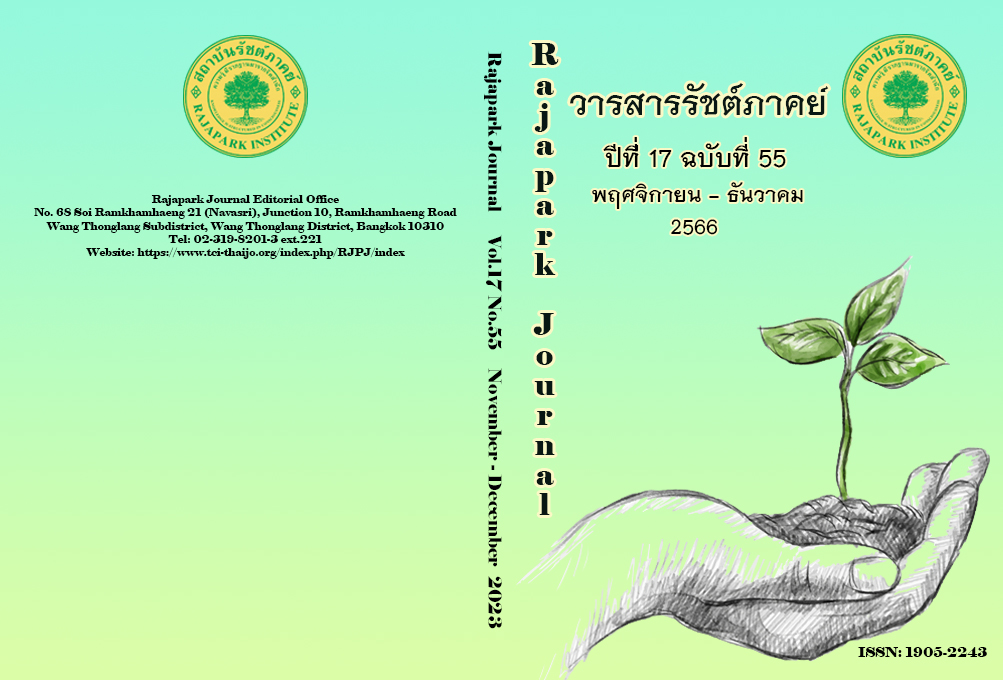Copyright Protection of Works Created by Artificial Intelligence
Main Article Content
Abstract
This research aimed to explore the problems related to works created by artificial general intelligence under Thai copyright law. In particular, Artificial Intelligence can create works on its own, both intentionally and independently. This research is documentary research, whereby Thai copyright law is discussed in comparison with the copyright law of the United Kingdom, the copyright law of the United States, and the European Union Database Directive. Additionally, the author has studied recommendations from international copyright law organizations and foreign court judgments. According to the study, this research has proposed that works created by artificial intelligence should be protected under Thai copyright law by sui generis rights. Finally, this researcher also proposes that programmers who created artificial intelligence or creators of artificial intelligence should have exclusive rights to works created by artificial intelligence because they are investors in the development and creation of artificial intelligence.
Article Details

This work is licensed under a Creative Commons Attribution-NonCommercial-NoDerivatives 4.0 International License.
Views and opinions appearing in the Journal it is the responsibility of the author of the article, and does not constitute the view and responsibility of the editorial team.
References
Beijing Film Law firm v Beijing Baidu Netcom Science & Techn. (2018). Jing 0491 Min Chu No.239. http://www.chinadaily.com.cn/specials/BeijingInternetCourtCivilJudgment(2018)Jing0491MinChuNo.239.pdf
Bently, L., & Sherman, B. (2014). Intellectual property law (4th ed.). Oxford University.
Bostrom, N. (2014). Superintelligence: Paths, dangers, strategies. Oxford University.
Bourbakis, N. G. (1992). Artificial intelligence methods and applications, Vol. 1. World Scientific. https://doi.org/10.1142/1734
Butler, T.L. (1982). Can a computer be an author - copyright aspects of artificial intelligence. Hastings Communications and Entertainment Law Journal, 4(4), 707-747. https://repository.uchastings.edu/hastings_comm_ent_law_journal/vol4/iss4/11
Calo, R. (2015). Robotics and the lessons of cyberlaw. California Law Review, 513-563.
CCH Canadian Ltd. v. Law Society of Upper Canada, [2004] 1 S.C.R. 339, 2004 SCC 13
Clifford, R. D. (1997). Intellectual property in the era of the creative computer program. Tulane Law Review, 71(6), 1675-1703.
Copyright, Designs and Patents Bill [H.L.] HL Deb 12 Nov. 1987 vol 489 cc1476-540. https://api.parliament.uk/historic-hansard/lords/1987/nov/12/copyright-designs-and-patents-bill-hl
Copyright, Designs and Patents Bill [Lords] HC Deb 28 April 1988 vol 132 cc525-99. https://api.parliament.uk/historic-hansard/commons/1988/apr/28/copyright-designs-and-patents-bill-lords
Design Data Corp. v. Unigate Enterprise, No. 14-16701 (9th Cir. 2017). https://law.justia.com/cases/federal/appellate-courts/ca9/14-16701/14-16701-2017-02-09.html
Dorotheou, E. (2015). Reap the benefits and avoid the legal uncertainty: Who owns the creations of artificial intelligence?. Computer and Telecommunications Law Review, 21(4), 1-15.
Elgammal, A., Liu, B., Elhoseiny, M., & Mazzone, M. (2017). CAN: Creative adversarial networks, generating “Art” by learning about styles and deviating from style norms. https://doi.org/10.48550/arXiv.1706.07068
Hristov, K. (2016). Artificial intelligence and the copyright dilemma. Idea, 57, 431-454.
Kaminski, M. E. (2017). Authorship, disrupted: AI authors in copyright and first amendment law. 51 U.C. Davis Law Review, 589. https://scholar.law.colorado.edu/faculty-articles/834.
Maidanyk, L. (2021). Artificial intelligence and sui generis right: A perspective for copyright of Ukraine?. Access to Justice in Eastern Europe, 3(11), 144–154. DOI: 10.33327/AJEE-18-4.3-n000076
Margoni, T., Guibault, L., & Wiebe, A. (2013). Safe to be open: Study on the protection of research data and recommendations for access and usage. Goettingen University. https://www.researchgate.net/publication/271908856_Safe_to_Be_Open_Study_on_the_Protection
_of_Research_Data_and_Recommendations_for_Access_and_Usage
McCarthy, J., Minsky, M. L., Rochester, N., & Shannon, C. E. (2006). A proposal for the Dartmouth summer research project on artificial intelligence, August 31, 1955. AI Magazine, 27(4), 12. https://doi.org/10.1609/aimag.v27i4.1904
Nova Productions Ltd v Mazooma Games Ltd & Ors Rev 1 [2006] EWHC 24 (Ch) (2006, Jan 20). http://www.bailii.org/ew/cases/EWHC/Ch/2006/24.html
Pearlman, R. (2017). Recognizing artificial intelligence (AI) as authors and investors under US intellectual property law. Richmond Journal of Law & Technology, 24(2), i-38.
Ralston, W. T. (2005). Copyright in computer-composed music: HAL meets Handel. Journal of the Copyright Society of the U.S.A., 52(3), 281-307.
Reznik, L. (2021). Intelligent security systems: How artificial Intelligence, machine learning and rearden LLC v. The Walt Disney Co., 17-cv-04006-JST (N.D. Cal. Jun. 8, 2022). https://casetext.com/case/rearden-llc-v-the-walt-disney-co
Seven Network (Operations) Ltd v TCN Channel Nine Pty Ltd [2005] FCAFC 144; 146 FCR 183 Torah Soft Ltd. v. Drosnin, 136 F. Supp. 2d 276 (S.D.N.Y. 2001). https://law.justia.com/cases/federal/district-courts/FSupp2/136/276/2579869/
Scott, M. D. (2019). Scott on multimedia law, Vol. 2 (4th ed.). Wolters Kluwer Law & Business.


